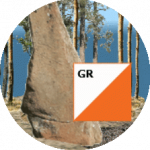Search the Community
Showing results for tags 'setPixel'.
-
When using the 2D context of a canvas each pixel has 4 components: red, green, blue and alpha (transparency). Each has a range from 0 to 255 (unsigned byte). Access to the data is via an object of type ImageData which has 3 properties: width, height and data. Data has the pixel values sequentially scanning horizontally and then downwards from top left. The data array therefore has a length equal to 4 times the number of pixels. It is possible to add getPixel() and setPixel() methods to the ImageData prototype but I will not call them exactly that in case the standard someday adds these anyway. So I could simply write /** Returns an array with 4 elements: RGBA. */ ImageData.prototype.grGetPixel = function (x, y) { var i = (this.width * Math.round (y) + Math.round (x)) * 4; // NB: JavaScript will try to index arrays with non-integers! return [this.data [ i ] , this.data [i + 1], this.data [i + 2], this.data [i + 3]]; }; /** rgba is an array with 4 elements: RGBA. * Ignores transparent pixels (A = 0). */ ImageData.prototype.grSetPixel = function (x, y, rgba) { var i = (this.wd * Math.round (y) + Math.round (x)) * 4; if (0 === rgba [3]) return; this.data [ i ] = rgba [0]; this.data [i + 1] = rgba [1]; this.data [i + 2] = rgba [2]; this.data [i + 3] = rgba [3]; }; BUT what about using the alpha transparency value? How is it supposed to be applied? Trying to find an algorithm in the working HTML5 standard, or in the W3 CSS standards or on the excellent MDN site all eventually lead to a short paragraph in the W3C standard for SVG: https://www.w3.org/TR/SVG11/masking.html#SimpleAlphaBlending . That says that it assumes the alpha to be premultiplied. To find out what that means see https://en.wikipedia.org/wiki/Alpha_compositing . Thanks to a section on another Wikipedia page (https://en.wikipedia.org/wiki/Alpha_compositing#Alpha_blending) I was able eventually to work out what I wanted to do. The next difficulty was that the alpha part of a canvas pixel has integer values in the range 0..255 but the compositing formulae need decimal multipliers in the range 0..1. Did I want to do a division, a / 255, every time I want to set a pixel? Certainly not: division is slow. Fortunately there are only 256 cases to consider so the solution is to set up a look-up table (LUT) when my program starts: var alphaLUT = new Array (256); // Converts index 0..255 to 0..1 for (var i = 0; i < 256; i++) alphaLUT [ i ] = i / 255; So my grSetPixel finally became /** rgba is an array with 4 elements: RGBA. * Ignores completely transparent pixels (A = 0). */ ImageData.prototype.grSetPixel = function (x, y, rgba) { var i = (this.width * Math.round (y) + Math.round (x)) * 4; if (0 === rgba [3]) return; var r = this.data [ i ] ; // Existing value, to be composited var g = this.data [i + 1]; var b = this.data [i + 2]; var a01 = alphaLUT [rgba [3]]; var a10 = 1 - a01; this.data [ i ] = (a10 * r + a01 * rgba [0]) & 0xff; this.data [i + 1] = (a10 * g + a01 * rgba [1]) & 0xff; this.data [i + 2] = (a10 * b + a01 * rgba [2]) & 0xff; this.data [i + 3] = 255; }; and it works a treat. I wanted to put glass signs in my forest. (Yes, I am oldfashioned - I see nothing wrong with var.)
-
- alpha transparency
- setpixel
-
(and 1 more)
Tagged with:
-
Hi everyone! Phaser version: 2.4.3. My intention was to render the cellular automata generated map on the screen. To do this I created a BitmapData object and used a basic set of setPixel(...) loops. Everything works but it took 8 seconds when the 'immediate' flag is true. And when the 'immediate' flag is false the map image just won't be visible at all while the console.log(...) says everything is finished so there's no freezing. Thus, the problem is in bmd.update(...) in the end that has no effect at all. Tried filling the entire bitmap with the white color before the loops: the entire bitmap is white but there's no trace of setPixel calls. create: function this.bmd = this.game.make.bitmapData(automata.width, automata.height);for (var i = 0; i < automata.width; i++) { for (var j = 0; j < automata.height; j++) { if (automata.cellmap[i][j]) this.bmd.setPixel(i, j, 255, 255, 255, false); }}this.bmd.update(0, 0, automata.width, automata.height);var img = this.bmd.addToWorld();img.smoothed = false;img.scale.set(2);
- 1 reply
-
- bitmapdata
- update
-
(and 2 more)
Tagged with:
-
Hi I'm having trouble with setpixel32, which according to the docs here (http://phaser.io/docs/2.4.8/Phaser.BitmapData.html#setPixel) can have an alpha value as the 6th argument. However when I try this it just plots over whatever is underneath with a fixed level instead of adding to it. Here is a jsbin to demonstrate the issue (using Phaser 2.4.8): http://jsbin.com/repewekopa/1/edit?html,js,output You'll notice that the alpha works fine with drawing a sprite to the bitmap, but if you substitute "bmd.draw(star, x, y);" with "bmd.setPixel32(x, y, 255, 255, 255, 77);" you'll see that you can only draw a uniform grey colour instead of having it build up as intended. Can anyone please tell me what I'm doing wrong, or if this is something that isn't possible with this method? As an extension question, is there any other faster method of plotting pixels with alpha?
- 3 replies
-
- bitmapdata
- setpixel
-
(and 1 more)
Tagged with:




